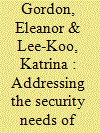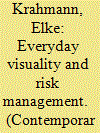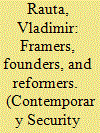|
|
|
Sort Order |
|
|
|
Items / Page
|
|
|
|
|
|
|
| Srl | Item |
| 1 |
ID:
177752


|
|
|
|
|
| Summary/Abstract |
Adolescent girls face significant and often unique forms of insecurity in protracted crises. Yet, their specific needs tend to be overlooked by international agencies, and they are rarely consulted as programs are developed and implemented. Drawing from field research conducted in four crisis contexts—Lake Chad (Niger, Nigeria, and Cameroon), South Sudan and Uganda, Lebanon (Beirut), and Bangladesh (Cox’s Bazar)—this article explores the experiences of insecurity that adolescent girls face in crisis contexts, and the extent to which responses to their needs are inclusive, responsive, and effective. Employing literature from inclusive peacebuilding, the article argues that marginalizing adolescent girls in the development and implementation of programs compromises the ability for such programs to be responsive to their needs. Moreover, it misses the opportunity to employ their skills, knowledge, and strengths to build resilience and security within their communities.
|
|
|
|
|
|
|
|
|
|
|
|
|
|
|
|
| 2 |
ID:
177753


|
|
|
|
|
| Summary/Abstract |
Visuality is a central aspect of everyday security governance. In the recent visual turn in International Relations, however, the more mundane and routine visualities of security have been widely neglected. To address this gap, this article proposes a framework for analyzing the messages of security and risk conveyed by different modes of visual representations, ranging from press photos and educational images to outwardly appearances. Taking the United Nations Organization Stabilization Mission in the Democratic Republic of the Congo (MONUSCO) as an example, it shows that everyday visual representations reflect and contribute to security risk management in four ways: (1) They assist in the construction of self and other identities with regard to security, (2) they help to identify potential vulnerabilities, (3) they are used to educate people how to detect, assess, and behave in risky situations, and (4) they are employed to deter violent attacks.
|
|
|
|
|
|
|
|
|
|
|
|
|
|
|
|
| 3 |
ID:
177754


|
|
|
|
|
| Summary/Abstract |
The rapid expansion of the proxy war literature invites an examination of its advances and developments. This article’s aims are threefold. First, to assess proxy war literature with a view to understand how it has progressed knowledge. Second, to map the field’s effort to cumulate knowledge. Third, to think creatively about the future directions of this research agenda as it addresses a problem no longer at the periphery of contemporary security debates. This article proposes a novel categorization of the evolution of our thinking about proxy wars across three “generations”: founders, framers, and reformers. Following on from this, it provides an assessment of the literature’s assumptions in order to show what remains, or not, under-studied. In doing so, it makes a case for a historiography of the idea of “proxy war,” and one for embedding strategy in analyses of wars by proxy.
|
|
|
|
|
|
|
|
|
|
|
|
|
|
|
|
| 4 |
ID:
177750


|
|
|
|
|
| Summary/Abstract |
Whether and how Lethal Autonomous Weapons Systems (LAWS) can and should be regulated is intensely debated among governments, scholars, and campaigning activists. This article argues that the strategy of the Campaign to Stop Killer Robots to obtain a legally binding instrument to regulate LAWS within the framework of the United Nations Convention on Certain Conventional Weapons is not likely to be effective, as it is modeled after previous humanitarian disarmament successes and not tailored to the specifics of the issue. This assessment is based on a systematic comparison of the autonomous weapons case with the cases of blinding laser weapons and anti-personnel landmines that makes use of an analytical framework consisting of issue-related, actor-related, and institution-related campaign strategy components. Considering the differences between these three cases, the authors recommend that the LAWS campaign strategy be adjusted in terms of institutional choices, substance, and regulatory design.
|
|
|
|
|
|
|
|
|
|
|
|
|
|
|
|
| 5 |
ID:
177751


|
|
|
|
|
| Summary/Abstract |
Many see the advent of lethal autonomous weapon systems as the next revolution in military affairs. Currently, some 30 countries share the view that these weapons should be preemptively banned, but we know relatively little about their motivations. This study contributes to the growing literature on “killer robots” by theorizing preventive arms control as an anticipatory response to military innovation. I suggest that states prefer preventive arms control when they lack capacities or incentives to pursue innovation in the first place. I analyze a cross-sectional dataset on national positions toward the ban on autonomous weapons and demonstrate that the probability of support for preventive prohibition decreases with increasing financial and technological capacities. Both democracies and autocracies are less likely to support the ban than mixed regimes. Conversely, states with strong humanitarian orientation and high socialization within specific arms control regimes are more likely to support the ban.
|
|
|
|
|
|
|
|
|
|
|
|
|
|
|
|
|
|
|
|
|